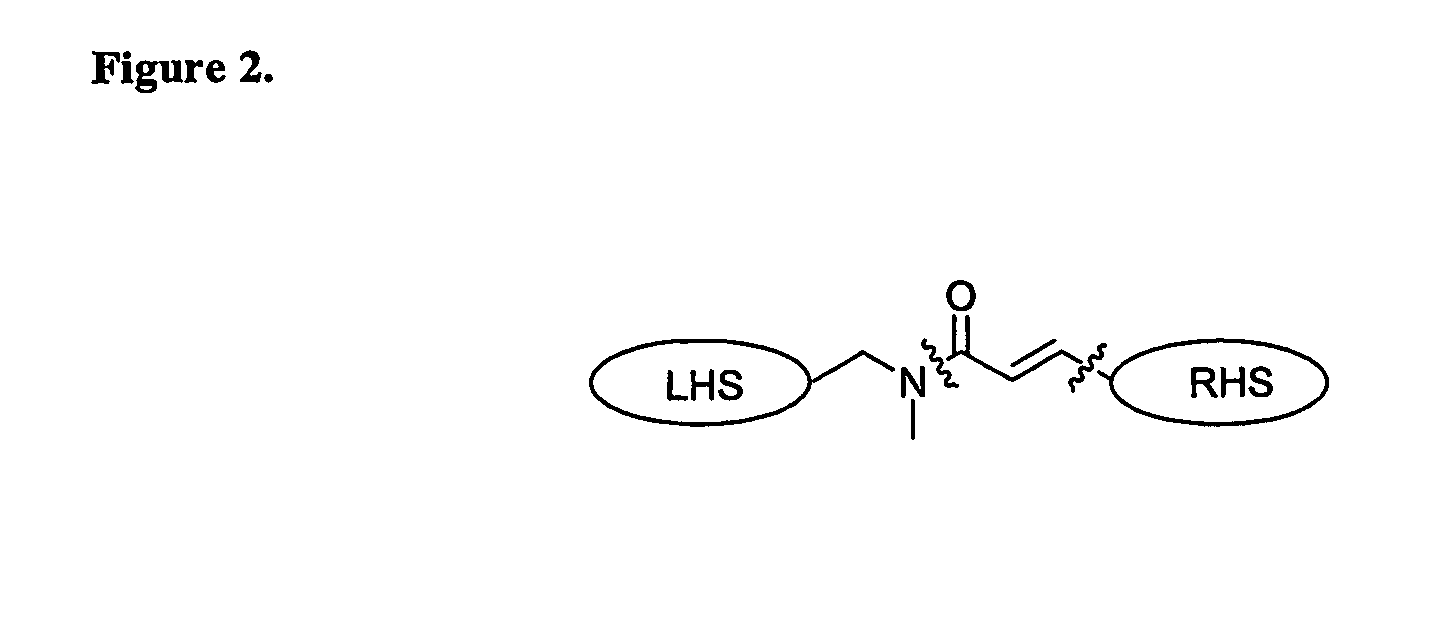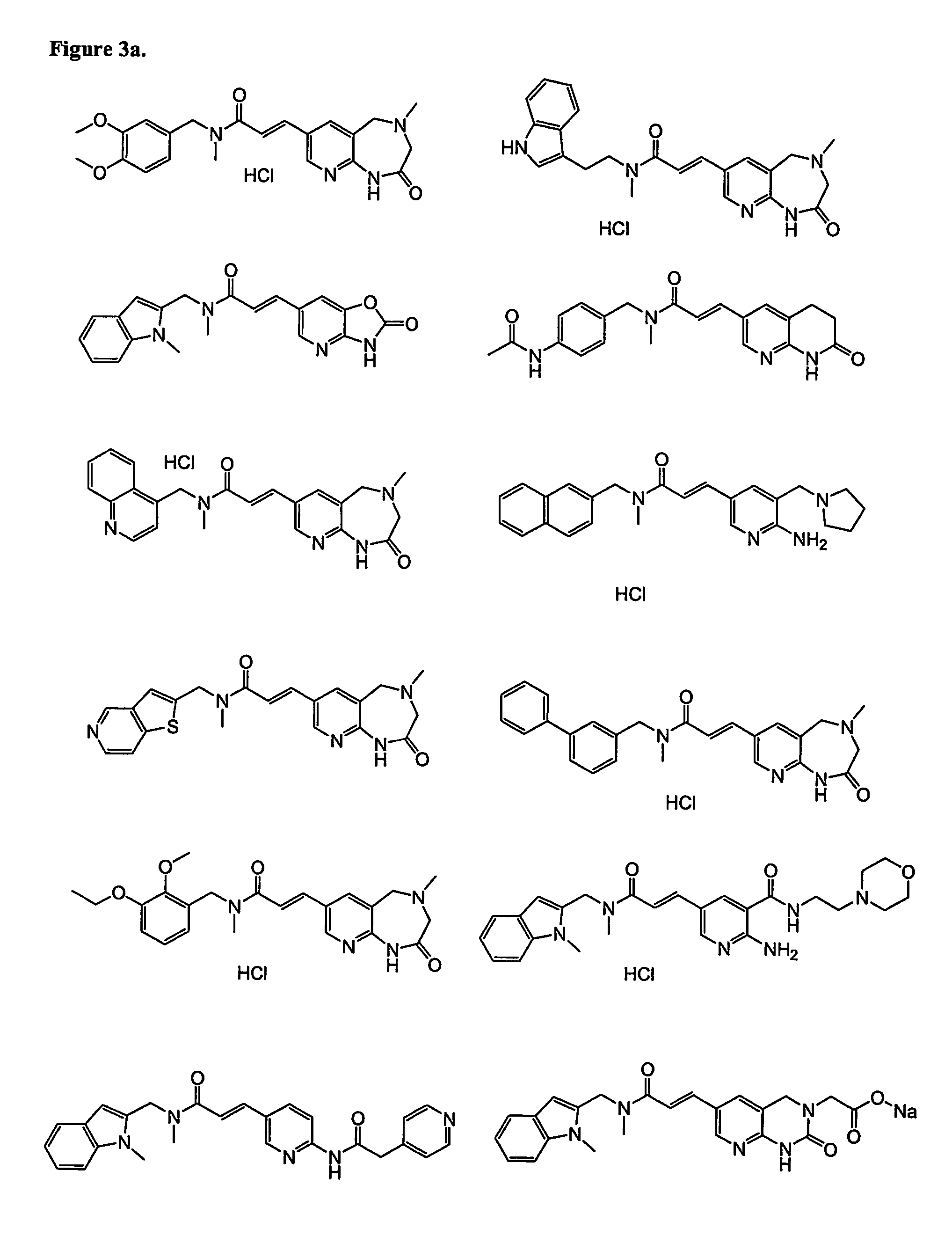Heterocyclic compounds, methods of making them and their use in therapy
a technology of heterocyclic compounds and cyclic aromatic compounds, applied in the field of heterocyclic compounds, methods of making them and their use in therapy, can solve the problems of unmet medical needs and demand for new agents acting against bacterial targets
- Summary
- Abstract
- Description
- Claims
- Application Information
AI Technical Summary
Benefits of technology
Problems solved by technology
Method used
Image
Examples
examples
General
[0501]Proton nuclear magnetic resonance (1H NMR) spectra were recorded at either 200, 300 or 500 MHz, and chemical shifts are reported in parts per million (δ) downfield from the internal standard tetramethylsilane (TMS) or from deuterated solvent. Abbreviations for NMR data are as follows: s=singlet, d=doublet, t=triplet, q=quartet, m=multiplet, dd=doublet of doublets, dt=doublet of triplets, app=apparent, br=broad. J indicates the NMR coupling constant measured in Hertz. CDCl3 is deuteriochloroform, DMSO-d6 is hexadeuteriodimethylsulfoxide, CD3OD is tetradeuteriomethanol and D2O is deuterated oxide. Mass spectra were obtained using electrospray (ESI) ionization techniques. Flash chromatography was carried out on E. Merck Kieselgel 60 (230-400 mesh) silica gel. Analytical HPLC was performed on Varian chromatography systems. Celite® is a filter aid composed of acid-washed diatomaceous silica, and is a registered trademark of Manville Corp., Denver, Colo. General abbreviations...
preparation 1
Preparation of Methyl-(1-propyl-naphthalen-2-ylmethyl)amine
[0502]A solution of 2.0 M methylamine in methanol (20 mL) was added to 1-propyl-naphthalene-2-carbaldehyde (0.983 g, 4.95 mmol) under N2 and allowed to stir for 18 h. The solution was concentrated under reduced pressure. Then the resulting dark yellow oil was solvated in EtOH (20 mL) under N2. To the solution was added NaBH4 (0.187 g, 4.95 mmol) and the mixture allowed to stir for 6.5 h. The reaction was concentrated under reduced pressure, then solvated in 1 N NaOH (20 mL) and extracted with Et2O (3×50 mL). The organics were combined, washed with brine (2×100 mL), dried over Na2SO4, filtered and concentrated to yield the title compound (0.94 g, 89%) as a yellow oil: 1H NMR (300 MHz, DMSO-d6) δ 7.87-7.73 (m, 4H), 7.51-7.43 (m, 3H), 3.53 (m, 1H), 2.09 (s, 3H), 1.70-1.52 (m, 2H), 1.26-1.12 (m, 2H), 0.87-0.79 (m, 3H).
preparation 2
Preparation of (4-Fluoro-naphthalen-1yl-1 methyl)methylamine
[0503]a) 4-Fluoro-naphthalene-1-carbaldehyde
[0504]A solution of α,α-dichloromethyl methyl ether (5.9 mL, 65 mmol) in CH2Cl2 (30 mL) was cooled in an ice bath and then treated dropwise over 15 min with SnCl4 (7.6 mL, 65 mmol). After stirring for 45 min, a solution of 1-fluoronaphthalene (5.5 mL, 50 mmol) in CH2Cl2 (30 mL) was added. The mixture was allowed to slowly warm to room temperature while stirring overnight. The mixture was poured in ice water (100 mL) and diluted with CH2Cl2 (50 mL). The layers were separated. The organic layer was diluted with CH2Cl2 (100 mL), washed with H2O (3×50 mL), dried over Na2SO4, filtered, and the solvent was removed in vacuo to give the title compound (7.62 g, 87%) as a pale yellow solid: MS (ESI) m / e 175 (M+H)+.[0505]b)(4-Fluoro-naphthalen-1-ylmethyl)methylamine
[0506]According to the procedure of Preparation 1, except substituting 4-fluoro-naphthalene-1-carbaldehyde for the 1-propyl-naph...
PUM
 Login to View More
Login to View More Abstract
Description
Claims
Application Information
 Login to View More
Login to View More - R&D
- Intellectual Property
- Life Sciences
- Materials
- Tech Scout
- Unparalleled Data Quality
- Higher Quality Content
- 60% Fewer Hallucinations
Browse by: Latest US Patents, China's latest patents, Technical Efficacy Thesaurus, Application Domain, Technology Topic, Popular Technical Reports.
© 2025 PatSnap. All rights reserved.Legal|Privacy policy|Modern Slavery Act Transparency Statement|Sitemap|About US| Contact US: help@patsnap.com



